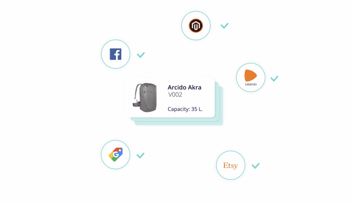Thanks to digitalization, the internet has become the world’s shopping mall for customers all around the world.
But the tricky thing is, they don’t only use a single channel to shop online. Depending on the customer and their needs, they may be browsing on web stores or popular marketplaces such as Amazon and Walmart, or other sales channels such as social media platforms. As a retailer, it is your job to know where your customers are and be everywhere they are.
Many Shopify store owners are currently killing it in multichannel commerce because they saw the importance of multichannel selling and acted on it early.
But, selling on multiple channels and winning at them isn’t without its challenges. But when you know what those challenges are and find effective solutions to them, you can become the next Shopify seller seeing success across the web.
Let’s explore!
The influx of product data you have to manage
When it comes to managing multiple retail channels, it can get rough, especially because you’ll have an influx of product data to manage.
Product data isn’t only about telling customers what it is that you sell, nowadays, customers want more than that. They want to feel connected to the products they are interested in buying. The way to achieve that is by ensuring that you have high-resolution images and videos, product titles that entice them, and product descriptions that tell them why they should buy your product instead of your competitors.
When you’re selling on multiple platforms, managing all that product information will become a messy affair. You’ll endure lagging spreadsheets, costly mistakes, scattered data, and storage limitations. This is why so many Shopify users are getting a PIM. They have seen firsthand how tiring managing a lot of product data is and how having a central location for all your media, product information, and marketing data is beneficial for multichannel distribution.
With a product information management system that comes equipped with a Shopify connector, you can store, manage, and enrich your data ALL in one place, which makes it easier for you and your team to manage tons of product data for multiple sales channels.
No two sales channel requirements are the same
As if the influx of product data wasn’t enough, you also have to deal with the reality that sales channels have different sets of requirements for using their platforms. They have rules on how they prefer to provide customers with an impeccable customer experience and sellers are expected to meet these specific requirements when it comes to image sizes, product descriptions, product titles, and branding.
As complicated and time-consuming as it is to create product information for each channel, if done right, you reap the benefits. For example, with Amazon, you can be featured on its Buy Box area or get advertising credits. When you don’t meet the requirements, your account may be suspended, which defeats your goals of multichannel selling.


But the good news is that you can solve this challenge with a product content tool. A PIM makes multichannel distribution easier as you can keep all content organized and distribute content to sales channels in the correct format faster than if you were doing the entire process manually.
With the Plytix PIM, all you have to do is select the products and relevant attributes for the specific channel, and the PIM will generate a feed that meets all the requirements in a matter of seconds. This saves you time and ensures you have accurate data that is error-free. With this intelligent PIM, you can say goodbye to long hours creating new sheets and hello to creating, and updating content easier and faster. This means you can simply focus on getting your product to your customers.
Ranking well enough to appear on page ONE
When we talk about doing everything right for marketplaces, it’s not only about meeting their requirements, it’s about ensuring your product information ranks well enough to appear on the first page.
Let’s put you in the shoes of a customer. When you're searching for a product, will you spend hours going through each page of the search results, or will you trust and look into the ones on the first page? Chances are you’ll stick to page one and maybe page two. Well, that’s what some customers do. In fact, 42% of consumers said they typically won’t scroll past the second page of results. And 12% of consumers ONLY browse the first page of results. As a business owner selling on marketplaces, we’d suggest focusing on making it on the first page.

To ensure your product ranks well, you need to optimize your product listing. Product listing optimization (PLO) is essential for popular marketplaces such as Amazon because it helps increase your product visibility. The first step is understanding search engines’ algorithms and using them to help lift your ranking, which, in turn, can lead to higher sales.
Each sales channel has its own algorithms, keywords you should target to rank, and specific format requirements. This means more content on your end! You’ll need to research relevant keywords, and use them to optimize product information such as titles, features, and descriptions, provide quality images, pricing, and more. Having PIM software allows you to store all your marketing data such as keywords, personas, SEO elements, and helps you push optimized content to all your sales channels.

Streamlining multichannel inventory management
When you sell on more than one channel, inventory and order management can become a hassle that even your ERP can’t handle alone. You need accurate, real-time data of your inventory records and a perfectly managed warehouse. Without a multichannel inventory management tool, you can experience challenges such as:
- Being understocked or overselling and not having updated inventory to each channel
- Lack of visibility on stock across channels and warehouses
Having a PIM tool can help improve your inventory because it easily integrates with your ERP. This means you get an overview of inventory and product information in a central location. That will help you efficiently manage your stock, helping ensure warehouse tracking is easier. And, because every single one of your products will have rich product detail information, you can rest assured that all the data you share is accurate, consistent, and as descriptive as possible to your suppliers. This ensures you don’t make any mistakes that may delay product arrival.

Managing customer experience on various channels
To ensure loyalty and that you generate more sales for your ecommerce business, you should prioritize customer experience. Creating a consistent customer experience may not be as easy as it was when you were only managing one sales channel. To ensure customer satisfaction and quality experience across channels, you need to understand your customer’s pain points, show them the value of the product, offer world-class customer support, and create a seamless experience for them.
With the help of a product analytics tool, you can easily track your customers' experience. Doing so allows you to track data for various sales channels by centralizing your data so that you can create flexible segmentation of product and channel groups, and view all your product impressions for both your web store and marketplaces in one place.
Thanks to our Google Analytics connection, you can see important data such as product impressions by location and channel, checkout funnel metrics for cart abandonment insights and so much more.
Be successful at multichannel selling with Plytix
There are a lot of challenges that come with multichannel commerce but don’t let bad product information management be one of them. A product information management tool like ours is the best PIM for Shopify because it helps you cut back on spending on an extensive ecommerce tech stack to excel in multichannel selling since one tool does what three or four used to. This next-generation PIM also helps you store all your data, edit it as you see fit, and analyze data to ensure that you KNOW whether or not you’re keeping your customers happy!
So, request a demo today and get a content syndication software that simply works.
If you can’t wait for your demo, start reading our latest whitepaper to gain more valuable insight on how you can succeed with multichannel commerce.




